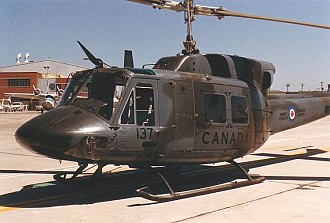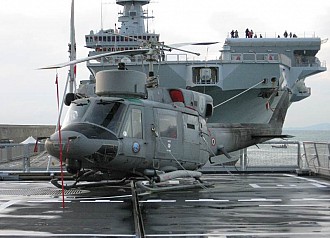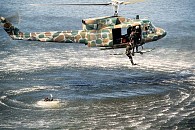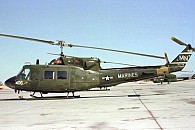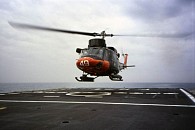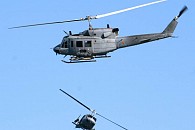Aircraft / Utility helicopters / Bell 212
Bell 212
General Facts
- TYPE
Transport helicopter - ORIGIN
 United States
United States - NICKNAMES
UH-1N (US military service)
Twin Two-Twelve (civilian designation)
CH-135 Twin Huey (Canadian service)
HP AH Mk1 (UK service)
HU.18 (Spanish service) - DESIGNED
1968 - 1970 - DESIGNER
Bell - PRODUCTION
1971 - 1990's - PRODUCERS
 Canada - Bell
Canada - Bell
 Italy - Agusta-Bell
Italy - Agusta-Bell
 United States - Bell
United States - Bell - QUANTITY
Unknown - UNIT COST
Unknown - CHARACTERISTICS
 Increased power and speed over Bell 205
Increased power and speed over Bell 205
 Parts commonality with Bell 205
Parts commonality with Bell 205
 Can perform emergency landing with one engine
Can perform emergency landing with one engine
 Reduced range and climb rate
Reduced range and climb rate
 Increased complexity due to additional gearbox
Increased complexity due to additional gearbox
Introduction
The Bell 212 is a transport helicopter of US origin. It was developed in the mid 1960's in cooperation with the Canadian government. It is a follow on to the successful Bell 205. As with earlier Bell helicopters the Bell 212 was also produced under license in Italy as the AB-212. A further development of the Bell 212 is the Bell 412 with a four blade main rotor.
Layout
The Bell 212 is based on the long fuselage of the Bell 205. Whereas the Bell 205 was powered by a single large engine the Bell 212 has two smaller engines side by side. The two engines deliver their power to a combining gearbox which in turn is connected to the shaft. Many parts are interchangeable with the Bell 205, including most of the airframe and the main and tail rotor.
Firepower
Most Bell 212 are unarmed or feature a 7.62mm machine gun in the doors. A small number has been fitted with gun and rocket pods, both in US service and for export sales. In Italy a special anti-submarine warfare version was developed. Most of these only carrried Mk 44 and Mk 46 torpedoes and AS-12 guided missiles. A limited number was fitted for anti-ship missiles such as the Sea Killer and Sea Skua.
Cargo
The internal volume is similar to the Bell 205, resulting in a similar capacity of 13 troops or 6 stretchers. The 1.8 t internal load capacity and 2.3 t sling capacity are an improvement over the Bell 205. The ability to carry more weight is what made the Bell 212 a more practical candidate for ASW conversion than its predecessor.
Mobility
The combined power output of the two turboshaft engines is more than that of the Bell 205, resulting in improved flight characteristics. The maximum speed is 269 km/h and cruise speed is 230 km/h. Only the range and climb rate have been slightly reduced. Should an engine fail the other engine is able to provide enough power for a safe landing, even at maximum weight.
Users
The Bell 212 and AB-212 have been produced in large numbers, although not as much as the Bell 205. Still over 60 nations from every continent adopted the Bell 212 or its Italian counterpart. Many nations, including the USA, adopted the Bell 212 because of its parts and maintainance commonality with the previous Bell 204 and 205.
Bell 212
Bell 212: Official Bell designation for Model 212 production for military use.
AB-212: Italian license production of Bell 212 by Agusta-Bell. It is identical to the Bell 212.
UH-1N: Standard Bell 212 in US military use.
HH-1N: Bell 212 with hoist for SAR duties.
VH-1N: Bell 212 for VIP transport.
- Specifications:
- Bell 212
| Type | Transport helicopter |
|---|---|
| Crew | 2 + 13 (2 pilots, 13 troops) |
| Lenght | 17.46 m rotors turning, 12.92 m fuselage |
| Width | 2.86 m stabiliser span |
| Height | 4.53 m to rotorhead |
| Weight | 2.79 t empty, 5.08 t MTOW |
| Rotors | Two blade main rotor, two blade tail rotor |
| Diameter | 14.69 m main rotor, 2.59 m tail rotor |
| Disc area | 174 m2 main, 5.3 m2 tail |
| Chord | ? |
| Powerplant | 2x Pratt & Whitney T400-CP-400, 1.290 hp combined during take-off, 1.130 hp continuous |
| Speed | 259 km/h max at sea level, 230 km/h cruise, 185 km/h economic |
| Range | 420 km |
|---|---|
| Fuel | 814 L |
| Climb rate | 6.7 m/s |
| Ceiling | 4.3 km |
| Endurance | ? |
| Landing gear | Skids, 2.64 m track |
| Armor | None |
| Cargo | 13 troops 6 stretchers 1.8 t internal cargo 2.3 t cargo on sling |
| Avionics | Standard flight controls |
| Self defense | ? |
| Remarks | - |
| Weapon systems | 2x 7.62mm machine gun |
| Fixed weapons | - |
|---|---|
| Hardpoints | - |
| Option 1 | Optional 7.62mm M60 machine gun in each door |
| Option 2 | - |
| Option 3 | - |
| Option 4 | - |
| Option 5 | - |
| Option 6 | - |
| Option 7 | - |
| Option 8 | - |
AB-212ASW
The AB-212ASW is a dedicated anti-submarine warfare version that is derived from the license produced AB-212. It is fitted with a dipping sonar system, a radar above the cabin and a hoist for SAR duties. It can be armed with lightweight torpedoes or various anti-ship missiles.
- Specifications:
- AB-212ASW
| Type | Naval helicopter |
|---|---|
| Crew | 4 + 5 (2 pilots, 2 crew, 5 passengers) |
| Lenght | 17.40 m rotors turning, 12.92 m fuselage |
| Width | 2.86 m stabiliser span |
| Height | 3.91 m to rotorhead |
| Weight | 3.42 t empty, 4.94 t on SAR mission, 5.07 t MTOW |
| Rotors | Two blade main rotor, two blade tail rotor |
| Diameter | 14.63 m main rotor, 2.59 m tail rotor |
| Disc area | 168 m2 main, 5.3 m2 tail |
| Chord | ? |
| Powerplant | Pratt & Whitney PT6T-6 Turbo Twin Pac, 1.875 hp |
| Speed | 240 km/h max at sea level, 196 km/h cruise, 185 km/h with armament |
| Range | 667 km with auxiliary fuel, 615 km with AS.12 missiles |
|---|---|
| Fuel | 1.021 kg internal, 356 kg external |
| Climb rate | 6.6 m/s |
| Ceiling | 3.2 km hovering in ground effect, 0.4 km out of ground effect |
| Endurance | 5 hours |
| Landing gear | Skids, 2.64 m track |
| Armor | None |
| Cargo | 7 troops 4 stretchers 490 kg of ordnance |
| Avionics | Standard flight controls, Bensix AN/AQS-15B/F sonar, MEL ARI-5955, MM/APS-705 or Sea Spray radar |
| Self defense | ? |
| Remarks | - |
| Weapon systems | Mk 44 torpedo Mk 46 torpedo AS-12 missiles Sea Killer missile Sea Skua missile 7.62mm machine gun |
| Fixed weapons | - |
|---|---|
| Hardpoints | 2 optional launch rails |
| Option 1 | Mk 44 or Mk 46 torpedo |
| Option 2 | AS-12 missile on each launch rail |
| Option 3 | Sea Killer missile on each launch rail |
| Option 4 | Sea Skua missile on each launch rail |
| Option 5 | Optional 7.62mm MG3 machine gun in each cabin door |
| Option 6 | - |
| Option 7 | - |
| Option 8 | - |


